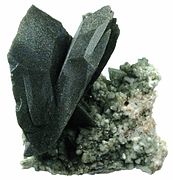Axinite
Appearance
| Axinite | |
|---|---|
 Manganaxinite | |
| General | |
| Category | Cyclosilicates |
| Formula (repeating unit) | (Ca,Fe,Mn)3Al2BO3Si4O12OH or Ca2(Fe,Mn)Al2BSi4O15(OH) |
| IMA symbol | Ax[1] |
| Strunz classification | 9.BD.20 |
| Crystal system | Triclinic |
| Crystal class | Pinacoidal (1) (same H-M symbol) |
| Space group | P1 |
| Identification | |
| Color | Reddish brown to yellow to colorless. Blue, violet, grey. |
| Crystal habit | Tabular, wedge shaped crystals |
| Cleavage | Good on {100} |
| Fracture | Conchoidal |
| Mohs scale hardness | 6.0–7.5 |
| Luster | Vitreous |
| Streak | White |
| Specific gravity | 3.18–3.37 |
| Optical properties | Biaxial (−) |
| Refractive index | nα = 1.672–1.693 nβ = 1.677–1.701 nγ = 1.681–1.704 |
| Birefringence | δ = 0.011 |
| Pleochroism | Strong |
| References | [2][3] |
Axinite is a brown to violet-brown, or reddish-brown bladed group of minerals composed of calcium aluminium boro-silicate, (Ca,Fe,Mn)3Al2BO3Si4O12OH. Axinite is pyroelectric and piezoelectric.
The axinite group includes:
- Axinite-(Fe) or ferroaxinite, Ca2Fe2+Al2BOSi4O15(OH) iron rich, clove-brown, brown, plum-blue, pearl-gray[4]
- Axinite-(Mg) or magnesioaxinite, Ca2MgAl2BOSi4O15(OH) magnesium rich, pale blue to pale violet; light brown to light pink[5]
- Axinite-(Mn) or manganaxinite, Ca2Mn2+Al2BOSi4O15(OH) manganese rich, honey-yellow, clove-brown, brown to blue[6]
- Tinzenite (CaFe2+Mn2+)3Al2BOSi4O15(OH) iron – manganese intermediate, yellow, brownish yellow-green[7]
Axinite is sometimes used as a gemstone.[8]
Gallery
[edit]-
Clove-brown axinite crystals to 2.3 cm set atop matrix from the West Bor Pit at Dalnegorsk, Russia
-
Chloritized bladed crystals of axinite forming on adularia from the Swiss Alps
-
Tinzenite on calcite, 4.5 × 3.5 × 3 cm. Wessels Mine, Kalahari manganese fields, Northern Cape Province, South Africa
-
Manganaxinite (Axinite-(Mn)), with sharp curving crystals to 4 cm. West Bor Pit at Dalnegorsk, Russia
References
[edit]Wikimedia Commons has media related to Axinite.
- ^ Warr, L.N. (2021). "IMA–CNMNC approved mineral symbols". Mineralogical Magazine. 85 (3): 291–320. Bibcode:2021MinM...85..291W. doi:10.1180/mgm.2021.43. S2CID 235729616.
- ^ Axinite Archived November 19, 2008, at the Wayback Machine. Mineral Galleries
- ^ Axinite. Mindat
- ^ Handbook of Mineralogy: Ferroaxinite
- ^ Handbook of Mineralogy: Magnesioaxinite
- ^ Handbook of Mineralogy: Manganaxinite
- ^ Handbook of Mineralogy: Tinzenite
- ^ Tables of Gemstone Identification By Roger Dedeyne, Ivo Quintens p.147



